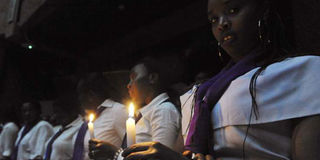Remembering victims of attack on Garissa college a year later

Former students of the Garissa University College light candles during the memorial service for the victims of last year's terrorist attack that killed 148 people at the campus of Garissa University College on April 2, 2016 in Nairobi. PHOTO | AFP
What you need to know:
- The gruesomeness of the attack and the scale of the casualties made headlines globally and drew worldwide condemnation and an outpouring of sympathy, particularly at university campuses.
- To date President Uhuru Kenyatta has yet to visit Garissa University College or any of the victims’ families.
- To the credit of Kenyans, the Garissa and other terrorist attacks in Kenya have not led to retaliatory attacks against Muslims, as has been witnessed in Europe and North America.
Last week marked the first anniversary of the terrorist attack on the Garissa University College when 147 students were gunned down by four terrorists during a dawn raid on the institution’s dormitories.
The number of students killed in the prime of their lives shocked the world. The gruesomeness of the attack and the scale of the casualties made headlines globally and drew worldwide condemnation and an outpouring of sympathy, particularly at university campuses.
Vigils organised by civil society groups for the dead students were held at Nairobi’s Uhuru Park and in several campuses around the world, including Zaghreb University in Croatia, where 147 students held a public demonstration during which they “played dead” in remembrance of the students who had been killed.
Unlike the high-profile memorial service held for the victims of the Westgate mall attack, senior government officials were significantly absent at the vigils, which made many Kenyans wonder whether the life of a poor student was worth less than that of the relatively wealthier victims who had died at Westgate.
To date President Uhuru Kenyatta has yet to visit Garissa University College or any of the victims’ families.
The tragedy was made even more painful by the fact that many of the students came from humble backgrounds and a large majority were the first in their families to acquire a university education.
The mother of one victim had sold her only plot of land to send her daughter to university. The parents’ loss was immeasurable; many had placed all their hopes and dreams for their future in their university-going children.
To the credit of Kenyans, the Garissa and other terrorist attacks in Kenya have not led to retaliatory attacks against Muslims, as has been witnessed in Europe and North America. This goes to show that while Kenyans tend to be ethnically divided, they exhibit remarkable religious tolerance.
However, the government’s response has been markedly different. Shortly after the Garissa attack, Deputy President William Ruto issued an order for all refugees in the Dadaab refugee camp to return to Somalia despite the fact that in 2013 Kenya signed a tripartite agreement with the Office of the United Nations High Commissioner for Refugees and the government of Somalia to facilitate the voluntary (not forced) repatriation of Somali refugees to Somalia.
Human rights bodies reported that extra-judicial killings of terrorism suspects had increased since the attack and that young men were disappearing from their homes, never to be seen again.
COLLEGE REOPENED
The Interior Cabinet Secretary announced that a wall would be built along the porous 900-kilometre Kenya-Somalia border. It was a clear case of scapegoating as all the four terrorists who attacked Garissa University College were Kenyan citizens, not Somali nationals — and only one of them was an ethnic Somali.
Thankfully, Garissa University College has since reopened. However, there has been no update on the great wall that was to be built along the Kenya-Somalia border while the issue of closing down the Dadaab camp has been the subject of negotiations between UNHCR and the Kenyan Government.
The Kenyan forces are still in Somalia. No one knows how many have died since Kenya entered that country in 2011 as the government has yet to release these figures, though Somalia’s President Hassan Sheikh Mohamud recently announced that 187 Kenyan soldiers had been killed during the recent attack on the El Adde camp. (Is President Mohamud privy to information that the Kenya Defence Forces/Amisom has not bothered to make public or did he get the numbers from Al-Shabaab, which is prone to gloating about such things?)
The European Union and other donors have announced their intention to reduce funding to Amisom, which could have an impact on the number of African troops on the ground in Somalia.
However, as the Somali national army is under-equipped, it is likely that Amisom will continue to have a presence in Somalia for some time to come, which is unfortunate as African Union soldiers have already been in Somalia for almost a decade.
On the other hand, regional entities such as Puntland and the self-declared independent “state” of Somaliland have been able to thwart the Al-Shabaab menace quite successfully.
Just last week, Puntland’s president claimed to have subdued an imminent attack by Al-Shabaab.
Interestingly, these are the very regions of Somalia where Amisom has no presence.





